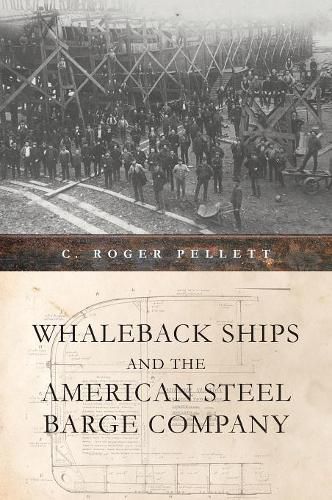Readings Newsletter
Become a Readings Member to make your shopping experience even easier.
Sign in or sign up for free!
You’re not far away from qualifying for FREE standard shipping within Australia
You’ve qualified for FREE standard shipping within Australia
The cart is loading…






From 1888 to 1898, the American Steel Barge Company built and operated a fleet of forty-four barges and steamships on the Great Lakes and in international trade. These new ships were considered revolutionary by some and nautical curiosities by others. Built from what was then a high tech material (steel) and powered by state-of-the-art steam machinery, their creation in the remote north was a sign of industrial accomplishment.
In Whaleback Ships and the American Steel Barge Company, C. Roger Pellett explains that the construction of these ships and the industrial infrastructure required to build them was financed by a syndicate that included some of the major players active in the Golden Age of American capitalism. The American Steel Barge Company operated profitably from 1889 through 1892, each year adding new vessels to its growing fleet. By 1893, it had run out of cash. The cash crisis worsened with the onset of the Panic of 1893, which plunged the country into a depression that mostly halted the ship-building industry. Only one shareholder, John D. Rockefeller, was willing and able to invest in the company to keep it afloat, and by doing so he gained control. When prosperity returned in 1896, the interest in huge iron ore deposits on the Mesabe Range required larger, more effi cient vessels. In an attempt to meet this need, the company built another vessel that incorporated many whaleback features but included a conventional Great Lakes steamship bow. Although this new steamship compared favorably with vessels of conventional design, it was the last vessel of whaleback design to be built.
Whaleback Ships and the American Steel Barge Company objectively examines the design of these ships using the original design drawings, notes the successes and failures of the company’s business strategy, and highlights the men at the operating level that attempted to make this strategy work. Readers interested in the maritime history of the Great Lakes and the industries that developed around them will find this book fascinating.
$9.00 standard shipping within Australia
FREE standard shipping within Australia for orders over $100.00
Express & International shipping calculated at checkout
From 1888 to 1898, the American Steel Barge Company built and operated a fleet of forty-four barges and steamships on the Great Lakes and in international trade. These new ships were considered revolutionary by some and nautical curiosities by others. Built from what was then a high tech material (steel) and powered by state-of-the-art steam machinery, their creation in the remote north was a sign of industrial accomplishment.
In Whaleback Ships and the American Steel Barge Company, C. Roger Pellett explains that the construction of these ships and the industrial infrastructure required to build them was financed by a syndicate that included some of the major players active in the Golden Age of American capitalism. The American Steel Barge Company operated profitably from 1889 through 1892, each year adding new vessels to its growing fleet. By 1893, it had run out of cash. The cash crisis worsened with the onset of the Panic of 1893, which plunged the country into a depression that mostly halted the ship-building industry. Only one shareholder, John D. Rockefeller, was willing and able to invest in the company to keep it afloat, and by doing so he gained control. When prosperity returned in 1896, the interest in huge iron ore deposits on the Mesabe Range required larger, more effi cient vessels. In an attempt to meet this need, the company built another vessel that incorporated many whaleback features but included a conventional Great Lakes steamship bow. Although this new steamship compared favorably with vessels of conventional design, it was the last vessel of whaleback design to be built.
Whaleback Ships and the American Steel Barge Company objectively examines the design of these ships using the original design drawings, notes the successes and failures of the company’s business strategy, and highlights the men at the operating level that attempted to make this strategy work. Readers interested in the maritime history of the Great Lakes and the industries that developed around them will find this book fascinating.